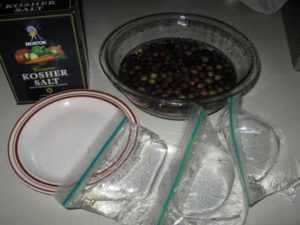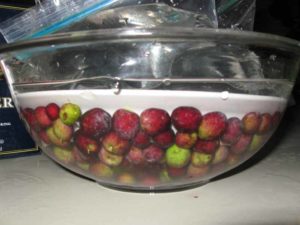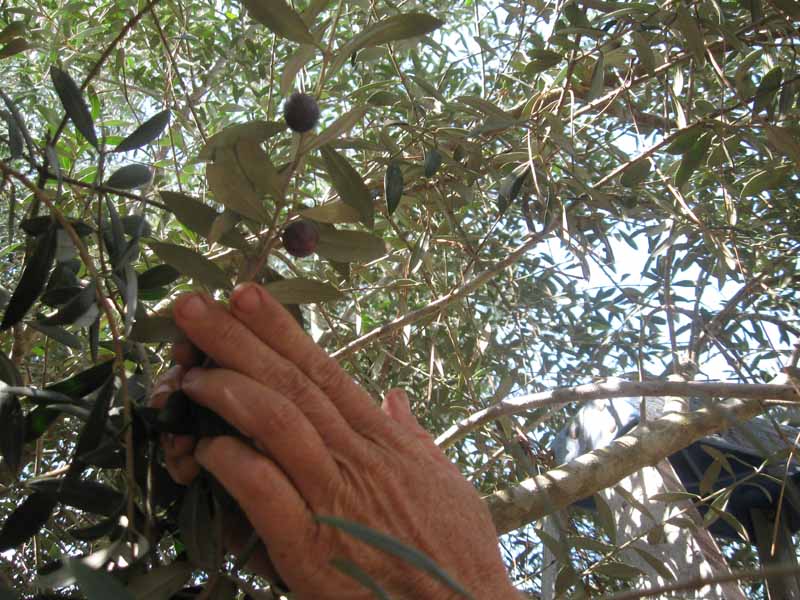[printfriendly]
Marinated Arbequina Olives
 Here’s a simple recipe that you can use to cure your Arbequina olives. It’s easily done with very little equipment, and the olives can be processed in small batches. Olives stored in oil will keep for several months in the refrigerator, and develop a rich and spicy flavor within a week or two. When you have finished eating all the olives, the leftover oil is wonderful served on bruschetta, or to use in salad dressings.
Here’s a simple recipe that you can use to cure your Arbequina olives. It’s easily done with very little equipment, and the olives can be processed in small batches. Olives stored in oil will keep for several months in the refrigerator, and develop a rich and spicy flavor within a week or two. When you have finished eating all the olives, the leftover oil is wonderful served on bruschetta, or to use in salad dressings.
PICKING YOUR OLIVES
 Olives, picked right off the tree, contain a bitter compound called oleuropein. Harvested olives must be cured to be palatable. The olives used in this recipe should be half to fully ripe. Pick them when the color is half black or fully black. Avoid fruit that is bruised or has spots, as these can cause rot, and will not store properly. Fresh olives should be processed as soon as possible after harvest. If unable to gather enough olives to process in a picking, store the gathered olives in the refrigerator until you have enough to process. Be sure to process within a week of harvest.
Olives, picked right off the tree, contain a bitter compound called oleuropein. Harvested olives must be cured to be palatable. The olives used in this recipe should be half to fully ripe. Pick them when the color is half black or fully black. Avoid fruit that is bruised or has spots, as these can cause rot, and will not store properly. Fresh olives should be processed as soon as possible after harvest. If unable to gather enough olives to process in a picking, store the gathered olives in the refrigerator until you have enough to process. Be sure to process within a week of harvest.
BRINING THE OLIVES
 Supplies Needed:
Supplies Needed:
Glass or ceramic bowl
Plate that fits well in the bowl
Quart bag filled with water to weigh plate down
Washed olives
Warm water
Kosher or non-iodized salt
 Common curing processes include brine, dry salt, water or lye. Different varieties of olives respond to different curing techniques. Arbequina is an olive traditionally used for oil production; it does not have a high bitter content and can be easily cured with a salt water brining process. To brine the olives, place washed fruit in a bowl. Fill bowl with enough warm water to cover olives with a couple of inches of water. Pick out and discard any olives that float. Add salt, stirring to dissolve, until all the olives are floating. When all the olives are floating you know you have the right strength of brine. Place plate on top of water with quart bag on top of plate. The combined weight will insure the olives are kept submerged in the brine solution. Let soak one week. Pour off water, rinse olives, and taste; if you’re happy with the flavor of the olives, they are ready for marinating; if still a little too bitter, repeat brining process for one more week.
Common curing processes include brine, dry salt, water or lye. Different varieties of olives respond to different curing techniques. Arbequina is an olive traditionally used for oil production; it does not have a high bitter content and can be easily cured with a salt water brining process. To brine the olives, place washed fruit in a bowl. Fill bowl with enough warm water to cover olives with a couple of inches of water. Pick out and discard any olives that float. Add salt, stirring to dissolve, until all the olives are floating. When all the olives are floating you know you have the right strength of brine. Place plate on top of water with quart bag on top of plate. The combined weight will insure the olives are kept submerged in the brine solution. Let soak one week. Pour off water, rinse olives, and taste; if you’re happy with the flavor of the olives, they are ready for marinating; if still a little too bitter, repeat brining process for one more week.
MARINATING THE CURED OLIVES
Sterilized half-pint or pint canning jars, with lids
Rinsed brined olives
Bay leaf
Rosemary sprigs
Peeled Garlic cloves
Olive oil
We have found the fruity flavor of the Arbequina to mix well with rosemary, bay leaf, and garlic, but don’t be afraid to experiment; other possible herbs to use are oregano, thyme, and sage. To marinate your olives, soak and rinse brined olives for a few minutes to remove some of the salt. Sterilize your jars and lids in boiling water, and set aside to cool. When jars are cool enough to handle, place a few sprigs of rosemary, a couple of bay leaves, and a clove of garlic in the jars, then pack with rinsed brined olives. Fill jars with olive oil. Screw lids on jars and set in a warm place for a couple of days to begin the marinating process. Finish marinating in the refrigerator. Olive oil stored in the refrigerator will become cloudy, but will clear up when brought back to room temperature. Olives should be ready to eat in a week or two, but develop better flavor over time. Store in refrigerator for up to 4 months. Enjoy!


